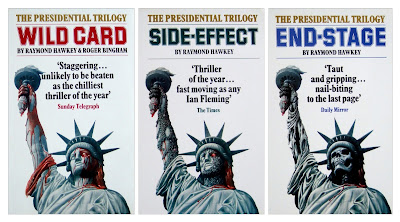Here's a weird one: a parapolitics thriller starring an unnamed President, set in a delightfully gonzo 197X near future setting where urban guerrillas have gotten ahold of suitcase nukes and the traffic is still hell on earth! The Fortress of America is coming apart at the seams, so science adviser Nadelman proposes some necessary evil: a faked UFO invasion, complete with an alien infection! Only such an otherworldly threat could possibly save these disunited states. The President isn't quite sold, but one assassination attempt later he begrudgingly signs off, and Wild Card lets loose.
Once we're off, however, the story proves muddled and unfocused. I'm glad the authors avoided two fisted filler and potboiler beats, but most of the way through it feels like we're reading a short story that just happens to keep going. There's nothing wrong with their writing per se, but things never quite come together, and threads fail to develop fully before we move onto the next sequence. And for all the acknowledgments front and back dedicated to real life scientists about the techniques described within, not much of it seems to come out in the final product, save for a deadly reveal one of the characters overhears, and a sci-fi device that comes in at the end to put a little twist on things. The alien building is fun though, as the scientists in the story play around with science fiction tropes and attempt to create realistic fictional invaders.
To Hawkey and Bingham's credit, there is a crackerjack disaster sequence near the end, and the usual downbeat '70s ending with a little cynical twist. Those creative scientists are finely drawn, a midcentury mix of careerists, ex-Nazis, and idealistic babes in the woods, none of whom can fully understand the tenuous nature of their continued employment - or survival! The authors also handle the President and his cabinet well, leaving him nameless and letting the setting speak for itself as to political developments in the near future. There's a lovely sequence near the beginning where the President watches a news broadcast and pays special attention to the graphic design on the little screen behind the anchor - he sees the Statue of Liberty and the US dollar getting destroyed, graphically on screen just as they are not-so-metaphorically outside in the real world. Hawkey was a graphic designer in another life and can be credited with the modern look of the airport thriller!
Wild Card's cover art from Ballantine Books is uninspired but gets the job done, and at least it's not as hackneyed as this Panther edition from 1976:
Hawkey wrote two more thrillers in the same vein sans Bingham, and they make up the loose Presidential Trilogy:
Everything in this goofy ride is eminently plausible, from false flag UFOs (some may also remember Reagan's fixation on alien invaders as a conduit to world peace) to domestic biowarfare (more ably presented in other thrillers like The Nightmare Factor and The Black Death, and partially archived among other places under the Special Virus Cancer Program). It's just a shame that it doesn't congeal into a successful story. Wild Card tries to go all in but busts out with a mediocre 2/4 rating.
Ballantine Books, 1974























































